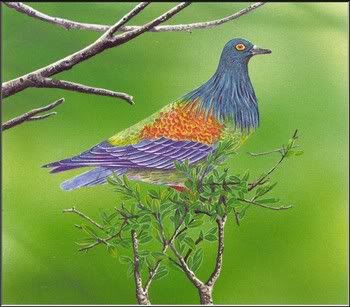|
|
Post by sebbe67 on Jun 5, 2005 16:01:50 GMT
Caloenas canacorum dove species from Tonga
I havent found any information aboout it, onl were it lived, anyone which knows more?
|
|
Deleted
Deleted Member
Posts: 0
|
Post by Deleted on Jun 5, 2005 16:06:28 GMT
Hi !
Caloenas canacorum is from New Caledonia.
Caloenas canacorum was larger than C. nicobarica, the bird must have been about 43 cm from head to tail. That's all I know.
Bye Alex
|
|
|
|
Post by another specialist on Jun 5, 2005 17:20:25 GMT
Caloenas canacorum Balouet & Olson 1989 Holocene of New Caledonia Primary materials: Holotype: right coracoïd Secondary materials: Paratypes: sternum fragment, left coracoïd, proximal part left scapula, distal part right humerus. Right coracoïdea, sternum fragment, scapulae, humerus Jean Christophe Balouet & Storrs L. Olson, Fossil birds from late Quaternary deposits in New Caledonia Smithsonian Contributions to Zoology 469 (1989): 1-38 Smithsonian Institution Press, Washington D.C. www.manu.pf/fossil.htmlwww.ornitaxa.com/SM/Fossil/FossilColumb.htm |
|
|
|
Post by Melanie on Oct 30, 2005 13:10:41 GMT
Elsewhere in Tonga, bird bones have been recovered from archeological sites on Tongatapu (unstudied; ref. 28), Niuatoputapu (only seabirds; ref. 29; unpublished observations), and Lifuka. From the Tongoleleka Site on Lifuka (Ha'apai Group), cultural strata that span much of Tonga's prehistory (ca. 3000-1000 years B.P.; refs. 30 and 31) produced bones of the megapodes Megapodius cf. molistructor and M. alimentum, the pigeons Caloenas cf. canacorum, Ducula cf. david, Ducula new sp., and D. pacifica, and starling Aplonis tabuensis (32). Only the last two species survive anywhere today. All except M. cf. molistructor and C. cf. canacorum have been recovered at 'Anatl. These two extinct species are otherwise known only from New Caledonia (33). www.pnas.org/cgi/reprint/90/3/818.pdf |
|
|
|
Post by Melanie on Oct 30, 2005 13:11:18 GMT
New Caledonia has two extinct columbids, both the largest in their respective genera, Gallicolumba longitarsus and Caloenas canacorum, the latter almost 25% larger than C. nicobarica (Balouet & Olson 1989). www.rsnz.org/publish/jrsnz/2001/40.pdf |
|
|
|
Post by another specialist on May 1, 2006 20:54:56 GMT
Caloenas canacorum  another from my computer |
|
|
|
Post by Bowhead Whale on Feb 15, 2007 19:32:43 GMT
When was it extinct?
|
|
|
|
Post by Melanie on Feb 15, 2007 19:54:58 GMT
|
|
|
|
Post by Bowhead Whale on Feb 21, 2007 21:07:32 GMT
Well, that's far back in time! Do we have any ancient representations of the bird, telling us what it was like?
|
|
Deleted
Deleted Member
Posts: 0
|
Post by Deleted on Feb 21, 2007 22:07:19 GMT
@ Bowhead Whale
No, not yet, as far as I know nobody of us did see any bones of this species.
|
|
|
|
Post by another specialist on Mar 23, 2007 8:56:38 GMT
From subfossil bones found on New Caledonia and Tonga, an extinct species, the Greater Maned Pigeon (Caloenas canacorum) was described. It was a sizeable bird, about one-quarter larger than the Nicobar Pigeon. Considering that it must have been a good source of food, it was most likely hunted to extinction by the first human settlers of the islands where it occurred.
It remains a mystery to me why New-Zealand has just one pigeon while at the same time much smaller islands have five or more. The species richness, taxonomic diversity, and geographic distribution of pigeons and doves (Columbidae) have been altered irreversibly in Polynesia by 3500 years of human activity. Natural (without human influence) columbid faunas are estimated primarily by studying prehistoric bones. In all Polynesian island groups studied (except outlying Easter Island, Hawaiian Islands, or New Zealand), the prehistoric columbid faunas had more species, more genera, and more species per genus than modern faunas from the same island. Congeneric species pairs or triplets occurred on many islands for Ducula, Ptilinopus, and Gallicolumba. The losses of Polynesian columbids include the extinction of at least 9 species in the genera Ducula, Ptilinopus, Macropygia, Caloenas, Gallicolumba, and Didunculus as well as the extirpation of numerous island populations of extant species. If not for human impact, a typical East Polynesian island would support at least 5–6 species of columbids in 3–4 genera (compared to 0–3 species in 0–3 genera today). A typical West Polynesian island would support at least 6–7 species in 4–5 genera (compared to 1–6 species in 1–5 genera today). Since all Polynesian pigeons and doves are frugivorous and/or granivorous, their decline in recent millennia probably has affected the composition of Polynesian forests by limiting inter- and intra-island dispersal of plant propagules. |
|
|
|
Post by another specialist on Aug 20, 2007 21:45:49 GMT
Greater Maned Pigeon, Caloenas canacorum (New Caledonia, Tonga) also known as Society Islands cuckoo-dove
|
|
Deleted
Deleted Member
Posts: 0
|
Post by Deleted on Aug 21, 2007 7:50:48 GMT
The name of this thread "Society Islands cuckoo-dove" should be chancheg, is this possible ?
|
|
|
|
Post by another specialist on Aug 21, 2007 8:17:34 GMT
The name of this thread "Society Islands cuckoo-dove" should be chancheg, is this possible ? Changed it Noisi to it latin name Caloenas canacorum instead of a common name. |
|
|
|
Post by another specialist on Sept 6, 2008 16:53:34 GMT
|
|